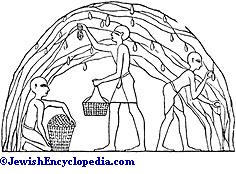BASKETS:

Four kinds of Baskets are mentioned in the Old Testament—"dud," "tene," "sal," and "kelub"—but unfortunately without any intimation whatever of the differences of shape or size between them; and even as to their uses only uncertain conclusions can be drawn. "Dud" ("pot," A. V.)is the carrying basket, borne in the hands (Ps. lxxxi. 7 [A. V. 6]; II Kings x. 7; Jer. xxiv. 2). It is used in Ps. lxxxi. 6 as a symbol of Egyptian bondage, connoting the basket in which the Israelites carried the clay for their bricks. This must therefore have been a large shallow basket such as the ancient Egyptians used for the purpose (Wilkinson, "Ancient Egyptians," i. 379). The term "dud" is applied also to the pot in which meat was boiled (I Sam. ii. 14), showing that not only the flatformed basket but also a pot-shaped one was known by this name. "Dud" may possibly be a general expression for vessels of various kinds. "Sal" is the term for the basket in which the Egyptian court baker had his confectionery, and which he carried on his head (Gen. xl. 16). It is also the usual term for the basket in which was placed the meat of the offering (Judges vi. 19), and likewise the unleavened bread (Ex. xxix. 3; Lev. viii. 2; Num. vi. 15). It is expressly stated that these unleavened cakes must be placed in such a basket and offered therein. "Sal" refers without doubt, therefore, to a small dish-shaped basket, perhaps of finer texture. Different from this was certainly the "tene," the large deep basket in which grain and other field-products were kept (Deut. xxviii. 5, 17), and the tithes transported to the sanctuary (Deut. xxvi. 2). Possibly this form of basket resembled that used by the Palestinian peasantry to-day for keeping wheat or oats; it is made of clay and straw and called "ḥabya." This has somewhat the shape of a jar; at the top is the mouth into which grain is poured, and at the bottom a small orifice through which small quantities are taken out as wanted and the opening closed with a rag. The term καρτάλλος, with which the Septuagint translates "tene," denotes a basket of the shape of an inverted cone. The term "kelub," finally, found in Amos viii. 1 for a fruit-basket, is used in Jer. v. 27 ("cage," A. V. and R. V.) for a bird-cage. It was therefore no doubt a coarsely woven basket with a cover, such as a fowler would use to carry home his captives. The word κοφῖνος used in the New Testament (Matt. xiv. 20 and elsewhere) seems to have meant a specifically Jewish utensil (compare Juvenal, iii. 14, "Quorum cophinus fœnumque suppellex," and Talmudic  and
and  ; Jastrow, "Dict." s.v.). In "Corpus Inscriptionum Græcarum," 1625, 46, the word denotes a Bœotian measure of about two gallons, from which fact a conclusion may perhaps be drawn as to the size of the basket.
; Jastrow, "Dict." s.v.). In "Corpus Inscriptionum Græcarum," 1625, 46, the word denotes a Bœotian measure of about two gallons, from which fact a conclusion may perhaps be drawn as to the size of the basket.

